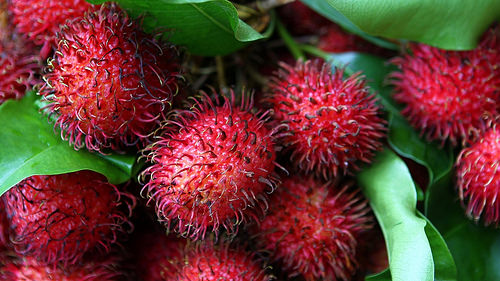Rambutans are sweet balls of flame and fire.
- Rambutans are a tropical fruit that grow on trees that are native to Southeast Asia, especially areas of Indonesia and Malaysia.
- The scientific name of the rambutan fruit tree is Nephelium lappaceum, and it is from the family Sapindaceae, the family of soapberries.
- The term ‘rambutan’ is derived from the word ‘rambut’ of the Indonesian and Malay languages, and is translated as ‘hair’.
- Rambutans are a spherical or slightly ovoid shape, typically 3 to 6 centimetres (1.2 to 2.4 inches) in length, with protruding thick spiky hairs.
- Usually ripe rambutans have a red skin colour, though yellow or orange varieties are available, and they have a flesh coloured white, sometimes with a pink tint.
 Rambutan
Rambutan
Image courtesy of Frank Fox/Flickr
- Rambutans feature a single seed that some have suggested is poisonous, and while the seed is bitter tasting when raw, it is suggested that once roasted or cooked, it is safe to eat.
- Rambutan fruit is green before it ripens and should stay on the tree until ripe; and the fruit is popularly cultivated in tropical areas, across Southeast Asia, southern Central America, parts of Africa and the Caribbean.
- Rambutan fruit have a fresh taste that is quite sweet, similar to lychee and longan fruit.
- It is common for rambutans to be eaten raw, however they can be made into a jam, or prepared in a salad or dessert.
- The nutritional content of rambutans is quite small, though varied, though it is a good source of vitamin C, fibre, copper and manganese.




